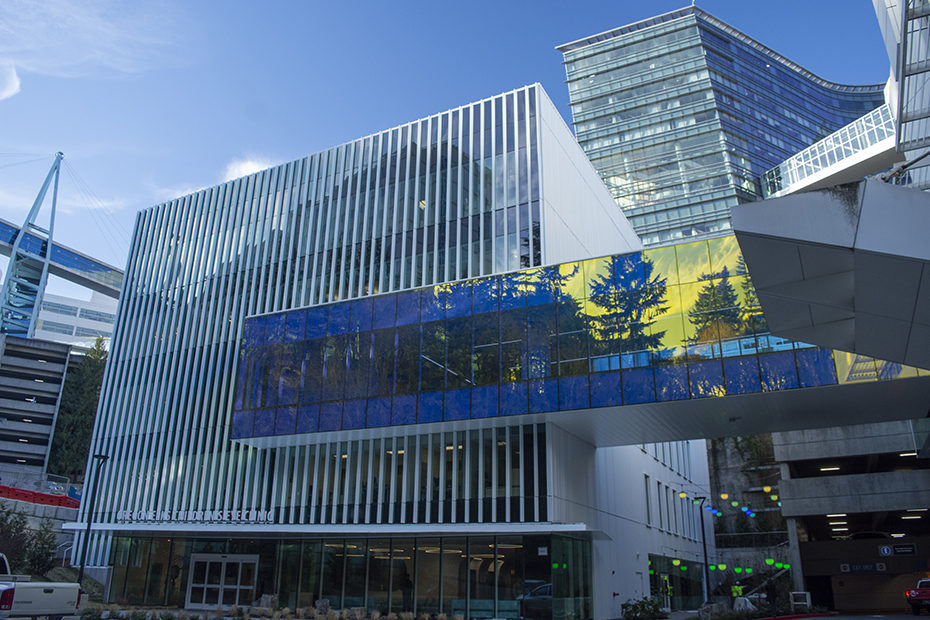
After several years of careful planning, design and construction, the new Elks Children’s Eye Clinic is now ready to serve patients from throughout the region and beyond. The state-of-the art facility, connected to the Casey Eye Institute building by a striking glass skybridge, is the first free-standing eye institute for pediatric patients in North America.
“The new Elks Children’s Eye Clinic represents a monumental game changer in pediatric ophthalmology,” said Daniel Karr, M.D., director of the Elks Children’s Eye Clinic and professor of ophthalmology, OHSU School of Medicine. “Because of the Oregon Elks’ enduring commitment to our program, we are now reaching a new plateau of care.”
The 60,000 square foot building will provide youngsters with a full range of comprehensive and subspecialty eye care under one roof, along with services for all ages in retina, ophthalmic genetics and vision rehabilitation. It is named in recognition of a significant philanthropic investment from the Oregon State Elks Association, which for 70 years has supported children’s eye care through the Elks Children’s Eye Clinic at Casey.
“This building is going to bring new innovations, new ideas, and new firsts for the people with sight threatening conditions here and abroad,” said Andreas Lauer, M.D., Thiele-Petti Chair, department of ophthalmology, OHSU School of Medicine. “We’ve become an internationally recognized institution and we look forward to building on that as we work towards our goal of ending preventable blindness in children and adults,” he said.
A hub and spoke model
Many programs in the new facility are based on a “hub and spoke” model, enabling them to extend their reach well beyond the building’s walls, said Casey director David Wilson, M.D.
“For example, our vision screening programs – which serve thousands of preschoolers and adults throughout Oregon each year - will be based here, where we can process information gained at the screenings and connect patients that need additional care to appropriate services,” said Wilson, who is the Paul H. Casey Chair, department of ophthalmology, OHSU School of Medicine.
That same arrangement applies to Casey’s renowned ophthalmic genetics program, whose “spokes” reach out to patients throughout the world who suffer from rare inherited eye disease. Its centralized functions in the new Elks Children’s Eye Clinic building, such as advanced diagnostic testing and genetic counseling, provide crucial support.
Defeating retinal disease
“This new building is really about growth and the opportunity to serve more patients with genetic eye disorders that cause blindness,” said Mark Pennesi, M.D., Ph.D., chief of the Paul H. Casey Ophthalmic Genetics Division. “The field of gene therapy to treat these diseases is increasing exponentially right now,” he said, noting that until recently, there was little that could be done for patients with inherited eye disease. “Now we’re starting to have treatments.”
The Paul H. Casey Ophthalmic Genetics Division occupies an entire floor in the new building and has all the unique elements needed for a successful gene therapy program, including a life-size mobility maze to test vision after treatment and rooms specially designed to examine patients in complete darkness.
“Dedicating such expansive space for the maze room shows Casey’s long-term commitment to curing these diseases and puts us in the top tier of institutions conducting the most advanced gene therapy trials,” he said. The division is named for the late Paul Casey, whose longstanding commitment to the eye institute included major support of its leading-edge program in ophthalmic genetics.

Capturing a sense of wonder
The new Elks Children’s Eye Clinic was designed to evoke a sense of playfulness and the wonder of vision, said Wilson, noting that “as a children’s eye clinic, we wanted to engage our youngest patients in a delightful way.” Patients and visitors approaching the building will be struck by its most iconic feature, a glass skybridge that dramatically shifts from blue to gold in response to outdoor lighting conditions and shows the reflections of nearby trees.
Other unique elements include a sensory garden, colorful outdoor lighting and a textured wall with ribbons of colored glass that mimic the light spectrum.

That whimsical theme also extends inside the building, where imaginative art work and images enliven the spaces. Special care was also taken to accommodate patients with all visual abilities. For example, a hand rail installed along the curved lobby desk serves as a guide to the elevators. And high contrast colors are used on floors, walls and signage to help patients and visitors safely navigate throughout the building.
The facility’s thoughtful and inspired design has garnered positive reviews, earning it awards from the Portland Design Commission and the Pacific Northwest Chapter of the International Interior Design Association.
“I really think of this new building as a ‘site for sight,’” said Wilson. “Over the past 20 years we’ve had remarkable success, in both medical science and community outreach and education. With the aging of the population, the need for eye services becomes even more critical.
“Thanks to the generosity of the Oregon Elks and our many donors, we will be able to grow all our programs and reach the populations we need to serve.”